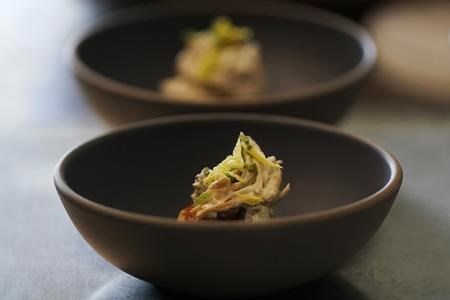Alberta
US approves chicken made from cultivated cells, the nation’s first ‘lab-grown’ meat

For the first time, U.S. regulators on Wednesday approved the sale of chicken made from animal cells, allowing two California companies to offer “lab-grown” meat to the nation’s restaurant tables and eventually, supermarket shelves.
The Agriculture Department gave the green light to Upside Foods and Good Meat, firms that had been racing to be the first in the U.S. to sell meat that doesn’t come from slaughtered animals — what’s now being referred to as “cell-cultivated” or “cultured” meat as it emerges from the laboratory and arrives on dinner plates.
The move launches a new era of meat production aimed at eliminating harm to animals and drastically reducing the environmental impacts of grazing, growing feed for animals and animal waste.
“Instead of all of that land and all of that water that’s used to feed all of these animals that are slaughtered, we can do it in a different way,” said Josh Tetrick, co-founder and chief executive of Eat Just, which operates Good Meat.
The companies received approvals for federal inspections required to sell meat and poultry in the U.S. The action came months after the U.S. Food and Drug Administration deemed that products from both companies are safe to eat. A manufacturing company called Joinn Biologics, which works with Good Meat, was also cleared to make the products.
Cultivated meat is grown in steel tanks, using cells that come from a living animal, a fertilized egg or a special bank of stored cells. In Upside’s case, it comes out in large sheets that are then formed into shapes like chicken cutlets and sausages. Good Meat, which already sells cultivated meat in Singapore, the first country to allow it, turns masses of chicken cells into cutlets, nuggets, shredded meat and satays.
But don’t look for this novel meat in U.S. grocery stores anytime soon. Cultivated chicken is much more expensive than meat from whole, farmed birds and cannot yet be produced on the scale of traditional meat, said Ricardo San Martin, director of the Alt:Meat Lab at University of California Berkeley.
The companies plan to serve the new food first in exclusive restaurants: Upside has partnered with a San Francisco restaurant called Bar Crenn, while Good Meat dishes will be served at a Washington, D.C., restaurant run by chef and owner Jose Andrés.
Company officials are quick to note the products are meat, not substitutes like the Impossible Burger or offerings from Beyond Meat, which are made from plant proteins and other ingredients.
Globally, more than 150 companies are focusing on meat from cells, not only chicken but pork, lamb, fish and beef, which scientists say has the biggest impact on the environment.
Upside, based in Berkeley, operates a 70,000-square-foot building in nearby Emeryville. On a recent Tuesday, visitors entered a gleaming commercial kitchen where chef Jess Weaver was sauteeing a cultivated chicken filet in a white wine butter sauce with tomatoes, capers and green onions.
The finished chicken breast product was slightly paler than the grocery store version. Otherwise it looked, cooked, smelled and tasted like any other pan-fried poultry.
“The most common response we get is, ‘Oh, it tastes like chicken,’” said Amy Chen, Upside’s chief operating officer.
Good Meat, based in Alameda, operates a 100,000-square-foot plant, where chef Zach Tyndall dished up a smoked chicken salad on a sunny June afternoon. He followed it with a chicken “thigh” served on a bed of potato puree with a mushroom-vegetable demi-glace and tiny purple cauliflower florets. The Good Meat chicken product will come pre-cooked, requiring only heating to use in a range of dishes.
Chen acknowledged that many consumers are skeptical, even squeamish, about the thought of eating chicken grown from cells.
“We call it the ‘ick factor,’” she said.
The sentiment was echoed in a recent poll conducted by The Associated Press-NORC Center for Public Affairs Research. Half of U.S. adults said that they are unlikely to try meat grown using cells from animals. When asked to choose from a list of reasons for their reluctance, most who said they’d be unlikely to try it said “it just sounds weird.” About half said they don’t think it would be safe.
But once people understand how the meat is made, they’re more accepting, Chen said. And once they taste it, they’re usually sold.
“It is the meat that you’ve always known and loved,” she said.
Cultivated meat begins with cells. Upside experts take cells from live animals, choosing those most likely to taste good and to reproduce quickly and consistently, forming high-quality meat, Chen said. Good Meat products are created from a master cell bank formed from a commercially available chicken cell line.
Once the cell lines are selected, they’re combined with a broth-like mixture that includes the amino acids, fatty acids, sugars, salts, vitamins and other elements cells need to grow. Inside the tanks, called cultivators, the cells grow, proliferating quickly. At Upside, muscle and connective tissue cells grow together, forming large sheets. After about three weeks, the sheets of poultry cells are removed from the tanks and formed into cutlets, sausages or other foods. Good Meat cells grow into large masses, which are shaped into a range of meat products.
Both firms emphasized that initial production will be limited. The Emeryville facility can produce up to 50,000 pounds of cultivated meat products a year, though the goal is to expand to 400,000 pounds per year, Upside officials said. Good Meat officials wouldn’t estimate a production goal.
By comparison, the U.S. produces about 50 billion pounds of chicken per year.
It could take a few years before consumers see the products in more restaurants and seven to 10 years before they hit the wider market, said Sebastian Bohn, who specializes in cell-based foods at CRB, a Missouri firm that designs and builds facilities for pharmaceutical, biotech and food companies.
Cost will be another sticking point. Neither Upside nor Good Meat officials would reveal the price of a single chicken cutlet, saying only that it’s been reduced by orders of magnitude since the firms began offering demonstrations. Eventually, the price is expected to mirror high-end organic chicken, which sells for up to $20 per pound.
San Martin said he’s concerned that cultivated meat may wind up being an alternative to traditional meat for rich people, but will do little for the environment if it remains a niche product.
“If some high-end or affluent people want to eat this instead of a chicken, it’s good,” he said. “Will that mean you will feed chicken to poor people? I honestly don’t see it.”
Tetrick said he shares critics’ concerns about the challenges of producing an affordable, novel meat product for the world. But he emphasized that traditional meat production is so damaging to the planet it requires an alternative — preferably one that doesn’t require giving up meat all together.
“I miss meat,” said Tetrick, who grew up in Alabama eating chicken wings and barbecue. “There should be a different way that people can enjoy chicken and beef and pork with their families.”
___
The Associated Press Health and Science Department receives support from the Howard Hughes Medical Institute’s Science and Educational Media Group. The AP is solely responsible for all content.
Jonel Aleccia And Laura Ungar, The Associated Press
Alberta
Big win for Alberta and Canada: Statement from Premier Smith

Premier Danielle Smith issued the following statement on the April 2, 2025 U.S. tariff announcement:
“Today was an important win for Canada and Alberta, as it appears the United States has decided to uphold the majority of the free trade agreement (CUSMA) between our two nations. It also appears this will continue to be the case until after the Canadian federal election has concluded and the newly elected Canadian government is able to renegotiate CUSMA with the U.S. administration.
“This is precisely what I have been advocating for from the U.S. administration for months.
“It means that the majority of goods sold into the United States from Canada will have no tariffs applied to them, including zero per cent tariffs on energy, minerals, agricultural products, uranium, seafood, potash and host of other Canadian goods.
“There is still work to be done, of course. Unfortunately, tariffs previously announced by the United States on Canadian automobiles, steel and aluminum have not been removed. The efforts of premiers and the federal government should therefore shift towards removing or significantly reducing these remaining tariffs as we go forward and ensuring affected workers across Canada are generously supported until the situation is resolved.
“I again call on all involved in our national advocacy efforts to focus on diplomacy and persuasion while avoiding unnecessary escalation. Clearly, this strategy has been the most effective to this point.
“As it appears the worst of this tariff dispute is behind us (though there is still work to be done), it is my sincere hope that we, as Canadians, can abandon the disastrous policies that have made Canada vulnerable to and overly dependent on the United States, fast-track national resource corridors, get out of the way of provincial resource development and turn our country into an independent economic juggernaut and energy superpower.”
Alberta
Energy sector will fuel Alberta economy and Canada’s exports for many years to come

From the Fraser Institute
By any measure, Alberta is an energy powerhouse—within Canada, but also on a global scale. In 2023, it produced 85 per cent of Canada’s oil and three-fifths of the country’s natural gas. Most of Canada’s oil reserves are in Alberta, along with a majority of natural gas reserves. Alberta is the beating heart of the Canadian energy economy. And energy, in turn, accounts for one-quarter of Canada’s international exports.
Consider some key facts about the province’s energy landscape, as noted in the Alberta Energy Regulator’s (AER) 2023 annual report. Oil and natural gas production continued to rise (on a volume basis) in 2023, on the heels of steady increases over the preceding half decade. However, the dollar value of Alberta’s oil and gas production fell in 2023, as the surging prices recorded in 2022 following Russia’s invasion of Ukraine retreated. Capital spending in the province’s energy sector reached $30 billion in 2023, making it the leading driver of private-sector investment. And completion of the Trans Mountain pipeline expansion project has opened new offshore export avenues for Canada’s oil industry and should boost Alberta’s energy production and exports going forward.
In a world striving to address climate change, Alberta’s hydrocarbon-heavy energy sector faces challenges. At some point, the world may start to consume less oil and, later, less natural gas (in absolute terms). But such “peak” consumption hasn’t arrived yet, nor does it appear imminent. While the demand for certain refined petroleum products is trending down in some advanced economies, particularly in Europe, we should take a broader global perspective when assessing energy demand and supply trends.
Looking at the worldwide picture, Goldman Sachs’ 2024 global energy forecast predicts that “oil usage will increase through 2034” thanks to strong demand in emerging markets and growing production of petrochemicals that depend on oil as the principal feedstock. Global demand for natural gas (including LNG) will also continue to increase, particularly since natural gas is the least carbon-intensive fossil fuel and more of it is being traded in the form of liquefied natural gas (LNG).
Against this backdrop, there are reasons to be optimistic about the prospects for Alberta’s energy sector, particularly if the federal government dials back some of the economically destructive energy and climate policies adopted by the last government. According to the AER’s “base case” forecast, overall energy output will expand over the next 10 years. Oilsands output is projected to grow modestly; natural gas production will also rise, in part due to greater demand for Alberta’s upstream gas from LNG operators in British Columbia.
The AER’s forecast also points to a positive trajectory for capital spending across the province’s energy sector. The agency sees annual investment rising from almost $30 billion to $40 billion by 2033. Most of this takes place in the oil and gas industry, but “emerging” energy resources and projects aimed at climate mitigation are expected to represent a bigger slice of energy-related capital spending going forward.
Like many other oil and gas producing jurisdictions, Alberta must navigate the bumpy journey to a lower-carbon future. But the world is set to remain dependent on fossil fuels for decades to come. This suggests the energy sector will continue to underpin not only the Alberta economy but also Canada’s export portfolio for the foreseeable future.
-

 2025 Federal Election2 days ago
2025 Federal Election2 days agoCanada Continues to Miss LNG Opportunities: Why the World Needs Our LNG – and We’re Not Ready
-

 International21 hours ago
International21 hours agoGermany launches first permanent foreign troop deployment since WW2
-

 2025 Federal Election2 days ago
2025 Federal Election2 days agoMainstream Media Election Coverage: If the Election Was a NHL Game, the Ice Would be Constantly Tilted Up and to the Left
-

 2025 Federal Election24 hours ago
2025 Federal Election24 hours agoPoilievre To Create ‘Canada First’ National Energy Corridor
-

 COVID-1919 hours ago
COVID-1919 hours agoMaxime Bernier slams Freedom Convoy leaders’ guilty verdict, calls Canada’s justice system ‘corrupt’
-

 International1 day ago
International1 day agoFREE MARINE LE PEN!’: Trump defends French populist against ‘lawfare’ charges
-

 Health2 days ago
Health2 days agoSelective reporting on measles outbreaks is a globalist smear campaign against Trump administration.
-

 2025 Federal Election2 days ago
2025 Federal Election2 days agoMark Carney is trying to market globalism as a ‘Canadian value.’ Will it work?







